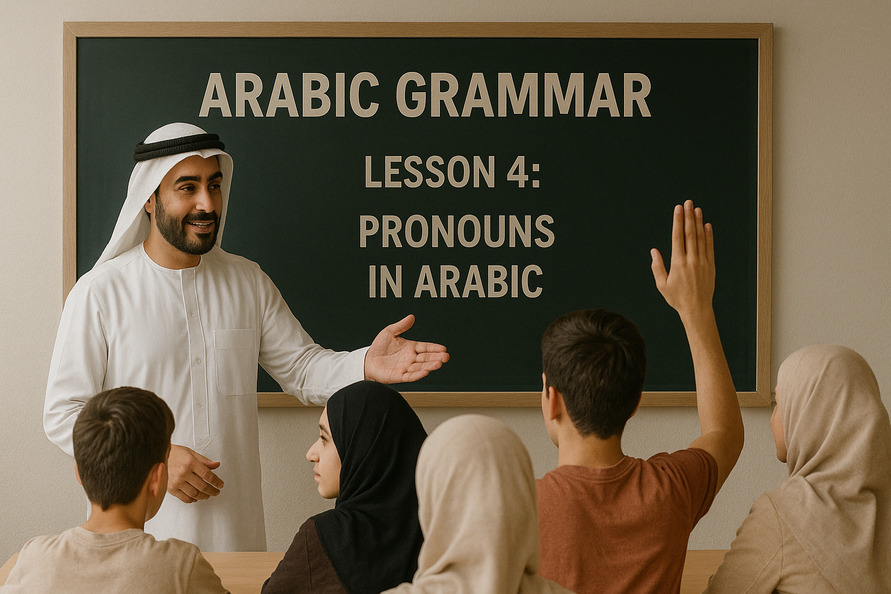Introduction: Master Every Arabic Pronoun from Day One
When you’re learning Arabic, the first thing you’ll want to say is “I” or “you.” And guess what? That’s a pronouns!
From “أنا” (ana) to “هم” (hum), this complete guide will take you step-by-step, from beginner basics to advanced uses, like possessives and verb agreements.
You’ll learn:
- ✅ Subject pronouns in Arabic
- ✅ Object pronouns in Arabic
- ✅ Possessive pronouns in Arabic
- ✅ Pronouns in verbs
- ✅ Gulf Arabic usage
- ✅ Examples with Roman script & English
Section 1: Subject Pronouns – Learn the Basics First
Subject pronouns are used to talk about the subject of the sentence – who is doing the action.
| Arabic | Roman Arabic | English | Notes |
|---|---|---|---|
| أنا | ana | I | All genders |
| إنتَ | inta | You (male) | Singular |
| إنتِ | inti | You (female) | Singular |
| هو | huwa | He | – |
| هي | hiya | She | – |
| إحنا | iḥna | We | All genders |
| إنتو | intu | You all | Plural |
| هم | hum | They | Masculine or mixed group |
| هما | humā | They (dual) | Rare in Gulf Arabic |
| أنتما | antumā | You two | Rare in Gulf Arabic |
Section 2: Easy Conversations with Pronouns
Example 1: Basic Intro
Arabic: مرحبا، أنا محمد. إنتَ من وين؟
Roman: Marḥaba, ana Muḥammad. Inta min wayn?
English: Hello, I’m Muhammad. Where are you from?
Example 2: Talking About Others
Arabic: هو يشتغل في المستشفى. هي تشتغل في المدرسة.
Roman: Huwa yishtaghil fil mustashfa. Hiya tishtaghil fil madrasa.
English: He works at the hospital. She works at the school.
Section 3: Object Pronouns – “Give it to Me”
Object pronouns are used when the pronoun receives the action.
| Arabic | Roman Arabic | English | Example Arabic | Roman | English |
|---|---|---|---|---|---|
| ـني | -ni | me | اعطني | aʿṭini | Give me |
| ـك (m) | -ak | you (m) | أحبك | uḥibbak | I love you (m) |
| ـكِ (f) | -ich (Gulf) | you (f) | أحبچ | uḥibbich | I love you (f) |
| ـه | -ah | him | شفته | shifta | I saw him |
| ـها | -ha | her | شفتها | shiftaha | I saw her |
| ـنا | -na | us | شافنا | shāfna | He saw us |
| ـكم | -kum | you all | شفتكم | shiftkum | I saw you all |
| ـهم | -hum | them | شفتهم | shifthum | I saw them |
Section 4: Possessive Pronouns – My, Your, His, Her
These attach to nouns and show ownership.
| Arabic | Roman | English | Example | Roman | English |
|---|---|---|---|---|---|
| ـي | -i | my | كتابي | kitābi | My book |
| ـك | -ak / -ich | your (m/f) | كتابك | kitābak / kitābich | Your book |
| ـه | -ah | his | كتابه | kitābah | His book |
| ـها | -ha | her | كتابها | kitābaha | Her book |
| ـنا | -na | our | كتابنا | kitābna | Our book |
| ـكم | -kum | your (pl.) | كتابكم | kitābkum | Your book |
| ـهم | -hum | their | كتابهم | kitābhum | Their book |
Section 5: Pronouns in Verbs – Agreement
Arabic verbs change depending on who is doing the action.
| Pronoun | Arabic Verb | Roman | English |
|---|---|---|---|
| أنا | أكتب | aktub | I write |
| إنتَ | تكتب | taktub | You (m) write |
| إنتِ | تكتبين | taktubeen | You (f) write |
| هو | يكتب | yaktub | He writes |
| هي | تكتب | taktub | She writes |
| إحنا | نكتب | naktub | We write |
| إنتو | تكتبون | taktuboon | You all write |
| هم | يكتبون | yaktuboon | They write |
Tip: In Gulf Arabic, these endings are often shortened:
- يكتبون → يكتبون (yiktiboon)
- تكتبين → تكتبين (tiktibeen)
Section 6: Advanced Conversation Using All Types of Pronouns
Arabic: إحنا نحب مدرسنا. هو يعطينا واجبات، وإنتو لازم تسوونها.
Roman: Iḥna niḥibb mudarrisna. Huwa yaʿṭeena wājbāt, w intu lāzim tisawwūnaha.
English: We like our teacher. He gives us homework, and you all have to do it.
| Word | Roman | Meaning |
|---|---|---|
| إحنا | iḥna | we |
| نحب | niḥibb | we love |
| مدرسنا | mudarrisna | our teacher |
| هو | huwa | he |
| يعطينا | yaʿṭeena | gives us |
| واجبات | wājbāt | homework |
| إنتو | intu | you all |
| لازم | lāzim | must |
| تسوونها | tisawwūnaha | do it (plural, her) |
Section 7: Quick Summary Tables
Subject + Object + Possessive
| Type | Example in Arabic | Roman | English |
|---|---|---|---|
| Subject | أنا | ana | I |
| Object | اعطني | aʿṭini | Give me |
| Possessive | كتابي | kitābi | My book |
Frequently Asked Questions (FAQs)
Final Thoughts: Now You Know Every Pronoun in Arabic!
From “أنا” to “هم”, you’ve now learned:
- ✅ How to use subject, object, and possessive pronouns
- ✅ Gulf Arabic pronunciation and usage
- ✅ Real-life examples with Roman script and breakdowns
- ✅ Verb-pronoun agreement
Now you can build full conversations confidently – whether you’re speaking to one person or a whole room full of friends in Kuwait or Dubai.
Ready to Keep Learning?
💡 Try our beginner-friendly Arabic Spoken Course
📘 Grab your copy of the Arabic Spoken eBook
👉 Explore our free Arabic Courses and Arabic Grammar Course












